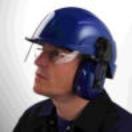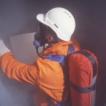|
SAFed
Health and Safety Passport Scheme Module
13 Personal Protective Equipment |
||||||||||||||
|
|
||||||||||||||
|
13.1
Introduction This document
forms one of a series of modules on various health and safety subjects that
comprise the examinable material considered necessary for the award of the
SAFed Health and Safety Passport. When you have
studied this module you should have acquired sufficient knowledge to be able
to complete the questions detailed at the end of the module.
Upon satisfactory completion of all modules, you will be eligible to
undertake the final assessment for the award of the SAFed Health and Safety
Passport. The SAFed
Health and Safety Passport is issued to Engineer Surveyors by the Health and
Safety Manager of their employing company upon satisfactory completion of the
Safety Passport final assessment. The award of the SAFed Health and Safety Passport provides evidence that the holder of the Passport has the appropriate knowledge and awareness in health and safety matters considered necessary for an Engineer Surveyor to undertake the duties for which they are authorised by their employing company. The passport is valid for a maximum of three years. |
||||||||||||||
|
13.2
Key Objectives Having
studied this module you should have an awareness of: ·
Legislation applicable to Personal Protective Equipment
(PPE) ·
Responsibilities for the provision and wearing of PPE This module is specifically focussed on personal protective equipment with respect to the responsibilities for provision and wearing of such equipment as well the type of equipment available. PPE is defined, in the regulations, as all equipment (including clothing affording protection against the weather) which is intended to be worn or held by a person at work and which protects him against one or more risks to his health or safety. |
||||||||||||||
|
13.3
Legal commentary The aim of the Personal Protective Equipment (PPE) at Work Regulations 1992 is to ensure that certain basic duties governing the provision and use of PPE apply to all situations where PPE is required. |
||||||||||||||
|
13.4
Discussion An employers responsibility is to identify specific risks and to eliminate those risks at source if possible. If that cannot be accomplished then the risks should be reduced and controlled by engineering methods such as isolation or local exhaust ventilation. When these controls are insufficient then adequate personal protective equipment should be provided. |
||||||||||||||
| 13.5 Personal Protective Equipment (PPE) | ||||||||||||||
|
||||||||||||||
|
PPE should
be clean and fit correctly and it must be suitable to combat the hazards for
the wearer and the job being undertaken. 13.5.1 Type of Equipment |
||||||||||||||
| PPE protects different vulnerable areas against different hazards: | ||||||||||||||
|
||||||||||||||
|
13.5.2 Choice
of PPE When
deciding what PPE should be worn there are essentially three aspects that
should be considered: ·
The workplace What sort, and how big, are the risks
that remain after all other controls? What
is an acceptable level of exposure to that risk? ·
The environment Are there any physical constraints
that should be considered? What
movement is required by the individual? Are there any temperature or
ventilation issue that should be considered? ·
The PPE wearer Has he been trained adequately? Does
the equipment fit? Does the PPE interfere with the work being carried out? Many sites will adopt an approach where signs are positioned at the entry points to certain areas that require a particular level of PPE: |
||||||||||||||
|
||||||||||||||
|
||||||||||||||
|
||||||||||||||
|
13.5.3 Description
of PPE Body protection Your
employer will supply suitable types of polyester and cotton boiler suits or
overalls. If you are working
where you may be in contact with asbestos, or other contaminated dust, then
disposable overalls should also be provided which should be discarded through
the specialist disposal systems available at the clients sites. Special
care should be taken in areas of high flammable gases or vapours where there
is likely to be a risk of static electricity build up. Ensure that all overalls have been washed before use for the
first time and do not enrobe or disrobe in such areas as this is likely to be
time when a static spark could be generated. You
should also be provided, by your employer, with specialist protective
equipment for working outside in poor weather as well as high visibility
clothing which is becoming routinely required on many sites. Clothing
can limit or restrict movement and also present an entanglement risk so
careful selection of type of clothing is required. Eye protection There
are three types of eye protection commonly available. The selection of which
type will depend on the potential hazard that is present: ·
Safety
glasses Provide protection against low-energy projectiles.
They are generally sized to fit
over prescription glasses if worn and so maybe easily dislodged. ·
Safety
goggles These offer a higher degree of protection than
glasses. They will offer some
protection against dust and high energy projectiles. · Face shield These provide full face protection. They are not normally provided as standard equipment and maybe provided by the client if required. |
||||||||||||||
|
Head protection This
level of protection is generally provided by either a safety helmet or a
bump cap. Bump caps do not
provide the same level of protection from falling objects as the helmet. If
your helmet has been subjected to sever impact it should be replaced even
though damage may not be readily apparent. The
expected life span of a safety helmet, under normal conditions, is 4 years.
The date of manufacture is stamped inside the helmet and you have the
responsibility of ensuring that a replacement is made before the expiry date. Exposure to heat and/or sunlight can make the material of the helmet become brittle. Care should be taken as to how and where the helmet is stored e.g. do not store your helmet in the rear window of your car. |
||||||||||||||
|
Breathing protection For
work in places with a known or suspected hazardous dust, mist, metal fume, gas
or vapour you should wear a suitable respirator. The main types of respirator that are commonly available are: ·
Filtering
half mask Basically a face mask that covers the mouth and
nose only. They are made from a
filtering material which removes the contaminants. ·
Half
mask respirator These have a rubber face piece and are
fitted with removable filter cartridges.
Good hygiene standards must be maintained to ensure that the respirator
continues to provide optimum protection. ·
Full
face respirator These are similar to the half mask
respirators however they cover the eyes, nose and mouth. · Powered respirator These provide a supply of clean filtered air. This equipment listed does not provide protection against oxygen deficient atmospheres and specialist equipment such as self contained breathing apparatus should be provided by the client. |
||||||||||||||
|
Ear protection
The main types of hearing protection are: ·
Earplugs
These fit into the ear canal and can be made from a variety of materials
such as polyurethane foam, rubber or glass down.
They are generally disposable, however where re-usable plugs are
supplied special care should be taken to avoid hygiene problems. · Earmuffs These consist of rigid cups which completely cover the ears, and are held in place by a head band. The cups are filled with sound absorbing material. The protective value of ear muffs may be lost entirely if objects such as hats or glasses intrude under or past the acoustic seals around the cups. |
||||||||||||||
|
Hand protection Gloves
give general protection from cuts and abrasions. They must be carefully selected, taking account of such
things as comfort, degree of dexterity required, ability to grip and the
degree of protection provided. Hazards
from actually wearing the gloves should also be considered such as
entanglement in moving parts of machinery. It should also be noted that the wearing of gloves should not be used as a substitute for safe practices e.g. do not run ropes through your hands even when gloves are being worn. |
||||||||||||||
|
Foot protection Safety
shoes or boots (fitted with protective toe caps) are designed to provide
protection for the feet, especially for the toes. They should be regularly inspected for condition,
particularly the soles. When in
good condition they are an effective means of preventing slips, trips or
falls. They may have mid sole steel plates as protection from penetration by sharp objects from beneath the sole of the foot. |
||||||||||||||
|
13.6
End of module and next steps Well done!
By reaching this point you will have finished studying this particular
module. You should now have
sufficient knowledge to answer the questions contained at the end of the module. Answers to
the questions should be forwarded to your Health and Safety Manager. Provided that
you have answered the questions correctly, your Health and Safety Manager will
forward to you your next self study module. |
||||||||||||||
| Click here to answer questions on Module 13 | ||||||||||||||











